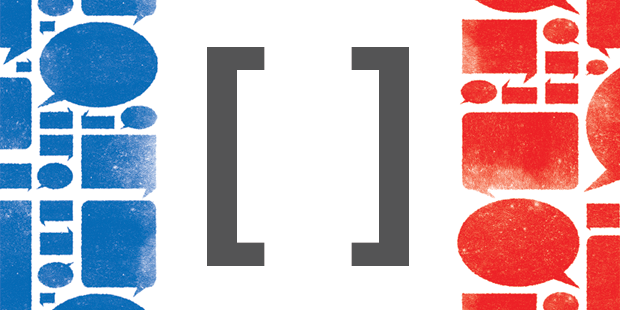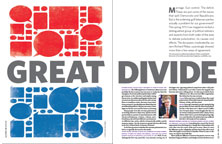Great Divide
Printer Friendly VersionMarriage. Gun control. The deficit. These are just some of the issues that split Democrats and Republicans. But is the widening gulf between parties actually a problem for our government? This spring, NYU Law magazine invited a distinguished group of political advisers and experts from both sides of the aisle to debate polarization, its causes and effects. The discussion, moderated by our own Richard Pildes, surprisingly showed more than a few areas of agreement.
This discussion was edited and condensed. Watch or read the full discussion here.
 RICHARD PILDES, Sudler Family Professor of Constitutional Law (moderator): The defining feature of American democracy over probably the last 20 years, but even more so today, has been the emergence of extreme political polarization within government, at the very least, and maybe among the rest of us. It is unlike anything that we have had in American democracy since the late 19th century. There is virtually no center. The most conservative Democrat now is considerably more liberal than the most liberal Republican. This process seems to have begun in the late 1970s and has been accelerating.
RICHARD PILDES, Sudler Family Professor of Constitutional Law (moderator): The defining feature of American democracy over probably the last 20 years, but even more so today, has been the emergence of extreme political polarization within government, at the very least, and maybe among the rest of us. It is unlike anything that we have had in American democracy since the late 19th century. There is virtually no center. The most conservative Democrat now is considerably more liberal than the most liberal Republican. This process seems to have begun in the late 1970s and has been accelerating.
Many people view this extreme polarization as making American democracy dysfunctional, particularly in a system of separated powers with checks and balances, a House, a Senate, and a Presidency, elected from different constituencies on different time cycles, which is dramatically unlike a parliamentary system. Can the American system function effectively in the face of these kinds of extreme divisions?
So the first question is whether this extreme polarization is as bad as is typically discussed in the media.
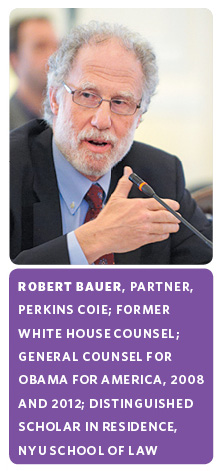 ROBERT BAUER, Partner, Perkins Coie; Former White House Counsel; General Counsel for Obama for America, 2008 and 2012; Distinguished Scholar in Residence, NYU School of Law: Well, let me distinguish this very powerful, very extreme sorting out of ideologies into opposing political camps from what I call polarized debate. Polarization is not what creates the singular dysfunction that we’re talking about. It is the way in which those differences are discussed and affect negotiation. The debate has become extreme.
ROBERT BAUER, Partner, Perkins Coie; Former White House Counsel; General Counsel for Obama for America, 2008 and 2012; Distinguished Scholar in Residence, NYU School of Law: Well, let me distinguish this very powerful, very extreme sorting out of ideologies into opposing political camps from what I call polarized debate. Polarization is not what creates the singular dysfunction that we’re talking about. It is the way in which those differences are discussed and affect negotiation. The debate has become extreme.
PILDES: Why aren’t you troubled about the actual polarization of the political parties beyond public debates, civility, and discourse?
BAUER: Years ago I remember people saying the biggest problem we have with the American political parties is that there isn’t a dime’s worth of difference between them. It was thought that the voters weren’t really presented with a sharp choice, debate didn’t have a particularly gleaming edge to it, and therefore the political process suffered. But that’s obviously not true anymore.
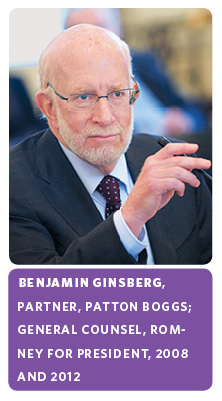 BENJAMIN GINSBERG, Partner, Patton Boggs; General Counsel, Romney for President, 2008 and 2012: Something has caused the elected representatives in Washington to change their relationships with each other over the course of the past 20 years. There is a notable difference in the collegiality and how much they talk to each other about golf or restaurants or families. When it comes to the cause, we need to deal with that.
BENJAMIN GINSBERG, Partner, Patton Boggs; General Counsel, Romney for President, 2008 and 2012: Something has caused the elected representatives in Washington to change their relationships with each other over the course of the past 20 years. There is a notable difference in the collegiality and how much they talk to each other about golf or restaurants or families. When it comes to the cause, we need to deal with that.
There really are differences between the parties now in a way that hasn’t happened before, and it helps to look at the three areas where that manifests itself in the policy realm. It’s certainly true in the size of government, all of these dangerous fiscal cliff actions that are taking place. It’s certainly true on the social issues, by and large, where there are just two concepts that are pretty far apart and hard to bridge the gap.
The military and our foreign policy muscle was the third area. Now, interestingly enough, you’d be hard pressed to really find great differences between the current president and the past president on most foreign policy matters. So we need to take a look within those particular issues for why this is happening.
PILDES: But why would certain issues be more polarizing today than in the past? Haven’t we always been deeply divided at some ideological level on these kinds of issues?
GINSBERG: The country is going through a growth spurt and hasn’t quite come to grips with who it is. You’ve written about the Voting Rights Act and how that started breaking up the coalitions. The Vietnam War tore the Democratic coalition asunder. Coalitions have been breaking up over the last 40 or 50 years and just aren’t quite re-formed yet. The media is a very different place today in terms of transmitting views than it was even 10 years ago. It’s much more polarized. Over the last 40 years people have come to live much more with people like them rather than in diverse communities. That contributes, too.
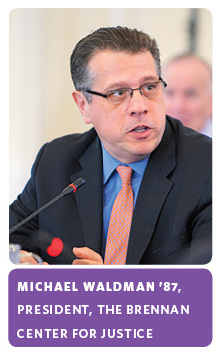 MICHAEL WALDMAN ’87, President, The Brennan Center for Justice: Well, the period of consensus that we think of as the norm from which we’ve deviated was itself unusual in American history. Many things that were the quirks of American politics have worked themselves out and are no longer so different. It used to be said that Americans were ideologically conservative and operationally liberal. Now people tend to sort out more in both of those areas.
MICHAEL WALDMAN ’87, President, The Brennan Center for Justice: Well, the period of consensus that we think of as the norm from which we’ve deviated was itself unusual in American history. Many things that were the quirks of American politics have worked themselves out and are no longer so different. It used to be said that Americans were ideologically conservative and operationally liberal. Now people tend to sort out more in both of those areas.
I have a book in my office, The Deadlock of Democracy, which not only talks about political parties not being responsible and you couldn’t tell what the difference was between them, but that there were really multiple party systems where conservative southern Democrats and northern liberal Republicans each played their own roles. Those vanished in the mid-1960s with the move of southern white Democrats slowly into the Republican Party, first for the presidency, then for the Senate, then for the House. Less noticed but just as significant, the Rockefeller Republicans disappeared in the Northeast. These big trends make us look more like a European-style ideologically divided party system. The challenge is not so much polarization but paralysis. Can we have a system as polarized as it is now without government being either paralyzed or lurching from one extreme to the other?
PILDES: That is one of the big questions. If we are forming Europeanstyle parliamentary parties—a much more unified Democratic Party, a much more unified Republican Party, much sharper differentiations between the parties—can those changes be made to work within an institutional framework from 200 years ago that wasn’t designed with the idea of political parties at all?
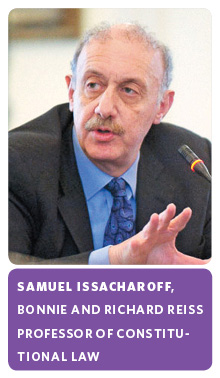 SAMUEL ISSACHAROFF, Bonnie and Richard Reiss Professor of Constitutional Law: I don’t find the polarization disturbing. People should disagree strongly about things like the death penalty or abortion or the size of the military or foreign interventions. What I find reassuring is that public opinion surveys generally show a bell-shaped distribution of views among the American population where the center still holds in terms of broad public views on even the most controversial issues. The difficulty is that the institutional framework through which those social views are mediated reinforces the poles. The election system where we use “first past the post”—that you get one more than the other side and you get everything—means that you’re going to end up with two basic parties.
SAMUEL ISSACHAROFF, Bonnie and Richard Reiss Professor of Constitutional Law: I don’t find the polarization disturbing. People should disagree strongly about things like the death penalty or abortion or the size of the military or foreign interventions. What I find reassuring is that public opinion surveys generally show a bell-shaped distribution of views among the American population where the center still holds in terms of broad public views on even the most controversial issues. The difficulty is that the institutional framework through which those social views are mediated reinforces the poles. The election system where we use “first past the post”—that you get one more than the other side and you get everything—means that you’re going to end up with two basic parties.
PILDES: Let’s talk about the dramatic change in the media over the last 10 years. We no longer have the three major broadcast networks with 25 million viewers and network anchors like Walter Cronkite or Tom Brokaw, centrists moderating representations of what’s going on in politics. Instead, we have cable television and the Internet, which is a much greater source of political information but which many people use to confirm the beliefs they already hold. How much is public opinion actually more polarized today? And how much are politics actually reflecting that polarization?
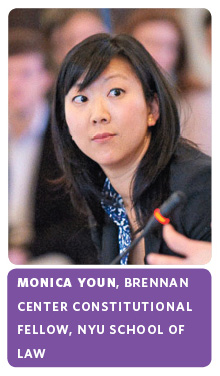 MONICA YOUN, Brennan Center Constitutional Fellow, NYU School of Law: People who study election law tend to be policy wonks, and that often leads to an assumption that people vote their policy preferences. Sam is absolutely right to say that there still is a relatively bell-shaped distribution of views on a number of social issues. What the evidence of the southern Democrats and the Rockefeller Republicans has hinted to me is that people will vote their party even despite their policy preferences. People’s affiliation towards parties may be less policy-based than tribal affective, more like a sports team or a religion.
MONICA YOUN, Brennan Center Constitutional Fellow, NYU School of Law: People who study election law tend to be policy wonks, and that often leads to an assumption that people vote their policy preferences. Sam is absolutely right to say that there still is a relatively bell-shaped distribution of views on a number of social issues. What the evidence of the southern Democrats and the Rockefeller Republicans has hinted to me is that people will vote their party even despite their policy preferences. People’s affiliation towards parties may be less policy-based than tribal affective, more like a sports team or a religion.
SEAN CAIRNCROSS ’01, Former Deputy Executive Director and General Counsel, National Republican Senatorial Committee: Today we woke up and found out that the House is moving toward an immigration package that is probably going to look like the Senate’s immigration package. So one of the most controversial issues of our current time where both parties have skin in the game looks to be moving forward. Just a little bit of perspective that we shouldn’t stand on the panic button.
But I agree with Ben that the relationships between the principals who negotiate these issues has changed. People travel home much more. There’s a 24-hour news cycle and the Internet, and you can rest assured that if you are cutting a deal or you are moderating on an issue that that is a very real force. I can tell you after two cycles at the senatorial committee that the potential for a primary challenge, and this is true on both sides of the aisle, is a significant constraint on your ability to negotiate.
PILDES: But what are the larger causes? I wanted to ask particularly about some institutional features of the election system that may be contributing. And should we consider changing some of them?
You all brought up primary elections, which is perhaps the single biggest institutional factor that contributes to the polarization of office holders today. Although primary elections were celebrated as great democratic achievements, wresting control of the choice of candidates from the smoke-filled back rooms of the party bosses in the late 19th century, over time voter turnout in primary elections, even for very significant races like for Senate, has become shockingly low. And not surprisingly the people who show up for primary elections in both parties are the most committed party activists, the most ideological wings of the parties. Certainly it’s a plausible argument that the Republicans would control the Senate today were it not for the primary election process over the last couple of cycles, in which more extreme candidates emerged—defeating sometimes long-serving incumbents—but who were not electable in the general election.
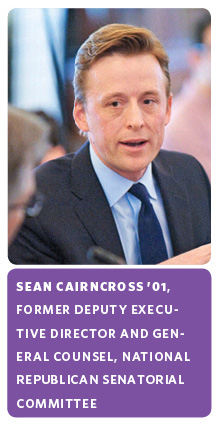 CAIRNCROSS: Let’s not lose sight of the voter. The people who show up in a democracy are going to determine what the governing structure looks like, and I’m not sure that you change that by going back to the smoke-filled room. We saw in the recent campaign that technology makes it easier to reach out and contact particular voters and motivate them to go to the polls. These new means of reaching people will have an impact on primaries. It doesn’t take much to change the course of a primary where there is very little turnout to begin with.
CAIRNCROSS: Let’s not lose sight of the voter. The people who show up in a democracy are going to determine what the governing structure looks like, and I’m not sure that you change that by going back to the smoke-filled room. We saw in the recent campaign that technology makes it easier to reach out and contact particular voters and motivate them to go to the polls. These new means of reaching people will have an impact on primaries. It doesn’t take much to change the course of a primary where there is very little turnout to begin with.
GINSBERG: It’s too early for me to sign onto the return to the smoke-filled back room, but I agree with Sean that you can’t forget the voter, that the mobilization efforts that have created bad results for Republican primaries in terms of being able to have better general election candidates are one of those thingsthat the voters have brought about.
Overall on the state level, you can’t overlook the impact that McCain-Feingold has had. The weakening of state parties on both the Republican and Democratic sides is profound. The personnel at state parties over the last decade have by and large migrated from people who were very involved in campaigns to people who care very much about policy. And the nuts and bolts of campaigns at the state level are much weaker today than they were in the past. So the state party brand on the local level is much more diffuse.
PILDES: Explain how the McCain-Feingold campaign finance reforms are a significant cause of the decimation of state and local political parties?
GINSBERG: Campaign finance “reform” eliminated money that’s legal under state law. So it is now a felony for the chairman of the Democratic or Republican National Committees to make a contribution to a candidate for governor with money legal under that state’s law. To even go out and raise the money for that candidate is now illegal. The result is that the party-building programs—voter registration, voter persuasion, get out the vote activities—must all now be done with federal money. State parties are uneven in their ability to raise especially federal money, and now do not get involved in primaries in the way that they once did nor in fundamental grassroots organizing.
PILDES: Are you also saying that the decimation of state parties is contributing to political polarization at the state level?
GINSBERG: Not only on the state level but also on the national level. This is a much longer conversation, but what parties have historically done for candidates—raised money, mobilized volunteers to mobilize voters to come out to vote, and messaging, which is basically advertising and, these days, independent expenditures—is not only done much less by the parties, but created a vacuum that has produced more robust special interest groups. It is much easier for a special interest group to raise money for a candidate, provide volunteers, and do ads for them. And, at least in our party, groups deeper in what you might call the “polarization zone” have been more adept at doing that.
PILDES: Unless you hope with Sean that turnout will change dramatically with the Internet, should we say it’s not healthy for democracy to have candidates chosen by such low-turnout electorates, and let’s start thinking about whether there are other ways of organizing the choice of candidates? Sam, you raised a hand to defend the smoke-filled back rooms.
ISSACHAROFF: Well, I used to be much more distrustful of elites choosing on behalf of the people, but I’ve grown accustomed as I’ve grown older.
PILDES: As you’ve grown more elite, of course.
ISSACHAROFF: Yeah, sitting at this table with the party elites and I don’t actively dislike them.
BAUER: We’re not actively hostile to you, either.
ISSACHAROFF: Ben’s point is absolutely critical on the weakness of the state-level parties. And it’s not just that they don’t perform the functions that Ben identified. They don’t groom the candidates. They don’t train. They don’t do all of the things that they used to do. We learned in the last two election cycles how an effective political organization can bring people out who might not have voted otherwise. This is something that the Republicans did effectively in 2004 and the Democrats did much more effectively in 2008 and 2012. The problem is you need a centralized organization with resources. At the primary stage you don’t have that. In 2004, 2008, and 2012, the national campaigns didn’t work through the state parties. They went out and mobilized voters themselves. There’s been an effort on behalf of both parties to push toward open primaries to draw a bigger swath of voters. You’re seeing different candidates emerging within the parties depending upon whether it’s an open or closed primary.
PILDES: Are you prepared to go that far and give it back to the party leadership?
ISSACHAROFF: Sure. We’ve done 100 years of this experiment, are we doing better for it or not? In 1972 the Democrats pushed very far in the direction of no party control of the nomination process, and they paid the cost for it. The Republicans are paying the price right now for ceding too much control. There were certain reform efforts, and Ben was obviously central in these, to rein that in a little bit to impose more institutional filters in the Republican process. So it’s not a question of going back completely to smoke-filled rooms—because we don’t allow smoking there anymore—but it is a question of recognizing that there have to be other institutional leverages to keep the primary system from degrading.
PILDES: Michael, as the president of the Brennan Center, which is very committed to increasing popular participation in politics and in elections, how do you feel about going back to the non-smoke-filled back rooms?
WALDMAN: We ought to look instead at ways to build on the mass participation model of the last few presidential cycles, which started with McCain in 2000, and find ways to use the new money and the new technology to make the primaries less the smoke-filled room of the super PAC and more something that actual
voters are participating in.
BAUER: Whether it was direct democracy, the top-two system, or, frankly, some of the engineering that was intended by McCainFeingold, these things typically don’t work out the way the sponsors have in mind. There’s simply no linear relationship between the problem they’ve identified, the institutional design feature that they craft, and the outcome that they’re looking for.
Take, for example, Stand by Your Ad. After all, we’re having a conversation about polarized debate, and the notion was there was too much negative advertising and therefore if we force candidates personally to state that they’ve approved the ad it will reduce the quantum of negative speech in the political process. And of course it didn’t. Period. That’s because very frequently, with the best of intentions, we design these features with an enormous amount of optimism that frankly experience belies.
Second, there was a discussion of campaign finance and state parties. And I significantly disagree with a couple of the comments made. I don’t think McCain-Feingold weakened the state parties. The truth is that the world had changed to the disadvantage of state parties for decades. Party money flowed from the states up to the federal government. By the time I began practicing in the 1970s that wasn’t true anymore, and critics would say that state parties and election cycles were pumped up with national activists who were sent to the states to run the state parties and with national resources that were sent to state parties. McCain-Feingold didn’t create that set of circumstances. It may have accelerated the difficulties of all of the parties. It certainly created some difficulties for the national parties by shutting off a main source of financial support, but it’s very difficult to say in my view that McCain-Feingold was responsible for it. So, the plea I’m issuing is for recognizing how often we fail with these institutional design issues. We become terribly excited at a particular moment by the panic of the day. Not too many years ago the view was that Republicans would never ever obtain control of the Congress unless they had term limits, and then they gave up term limits once they gained control of the Congress.
PILDES: Okay, let’s come back to the issue that Bob put on the table that the problem is not polarized parties but the nature of debate, discourse, and the like. Monica, is that a significant problem now? Do they no longer want to get together because they’re spending so much time raising money, or because polarization itself makes it politically costly to get together with people from the other side of the aisle?
YOUN: People who have spent more time in DC than I can talk about the softer cultural factors. But a lot of the problem does reflect the polarization of the electorate. The electorate will always say, Oh, yes, we want reasonable, moderate, bipartisan solutions, but when push comes to shove the electorate will say, What we really want is for our party to trounce the other guys and to win this debate that we’re on. And if you take it to the level of the individual voters, the politicians are responding to demand rather than otherwise.
PILDES: Michael, you’ve written in particular about the very polarized debates on voter identification issues and laws that have been emerging over the last two or three years. And what we see there is that, at least within legislative bodies, the votes on these laws break down on completely partisan lines, although public opinion polls generally seem to suggest that three-quarters of voters endorse these kinds of laws.
WALDMAN: The voting wars of the past decade are a symptom rather than a cause of the polarization. There have always been challenges about who could vote, but there has not been as sharp a red/blue divide as now. The public has broad but not particularly deep views on these matters. On the one hand, there’s broad public support for something like voter ID. On the other hand, when you point out that a lot of people don’t have the particular kind of ID that’s being proposed, the public voted against it, as in Minnesota. The real challenge is how to advance something where there is in fact a solution that meets the concerns of both sides in the debate, as I would argue is the case here.
PILDES: What is that solution?
WALDMAN: Well, you could have a system that registers just about every voter and is less susceptible to fraud. And even on the very polarized issue of voter ID, you’re now starting to see proposals around the country, as in Nevada, where the Democratic secretary of state has proposed a system where you have to have an ID. But if you don’t have it, your photo gets taken at the polls. That has the potential to calm concerns about security without disenfranchising people.
There are some real solutions. We’re seated at the table with the co-chairs of the president’s new commission on electoral reform [Bauer and Ginsberg]. If we could find a way to take these issues out of the partisan crossfire, it’s far more likely to get a solution that actually meets the concerns of all parties.
PILDES: Can we take these issues out of the partisan crossfire, especially at the national level?
WALDMAN: Sometimes, when both parties want something, whether it’s a grand bargain between them, or, as in immigration, where suddenly both parties for entirely different reasons want exactly the same thing. But it’s important not to neglect some of the soft matters of leadership. The filibuster rules are the same as they’ve been for a long time, but all of a sudden they’re used so incessantly that you suddenly need an impossible supermajority to do anything in the Congress. There are numerous things where the rules are what they are on paper, but if leaders of both parties aren’t willing to stand up to their base or exert leadership then the system breaks down. The polarization that we’ve seen is not only a function of the voters or even the money in the system pulling people, but the difficulty that people inside the system have had resisting it.
PILDES: Ben, you’re the one who opened up the personal side of polarization. What, in your view, accounts for the situation Michael is describing?
GINSBERG: I’m honestly not sure. One of the contrasts with the atmosphere in Washington is on the state level, where there are any number of governors from both parties in either unified or divided legislatures who have managed to get an awful lot done in their states. So despite the polarization that we’re talking about, and we’re really talking about it as a national phenomenon, in any number of states it’s not true. I’m not really sure what the differences are temperamentally and in the relationships between people, and why it is different in Washington from the way it is in so many state capitals.
BAUER: There’s no question that the tenor of relationships in the city has changed. When I came to Washington, DC, full time in 1976, there was a very different quality to relationships across the aisle. Sometimes the rhetoric was still very hard edged, but there was more of a likelihood that you would see the previous combatants walking off the floor of the Senate joking with each other. And that’s very different than the reported period, post-1994 election, when the Democratic leader of the House and the Speaker of the House did not speak to each other for a year and a half directly. So there’s a difference, but to go to Michael’s distinction, it’s more of a symptom than a cause of the larger divide.
ISSACHAROFF: American government has traditionally depended upon two different things, which both are in short supply right now. One is people who rise above the partisan divides in the institution and are the deal brokers, and there seem to be fewer of those due to the decline of the center.
The other is that there seems to be less identification with the institution than with one’s party. If you look at the separation of powers, there is a Senate that has an understanding of its role, and a House in the same way, and a presidency organized around the executive in opposition to the Congress and to the judiciary. That seems to have broken down. There seems to be willingness to disable the various institutions in favor of an immediate partisan objective. The causal stuff is hard to figure out because there’s so many factors: that life is more transparent, that our sources of information are more available. The monopoly of information under Walter Cronkite was a terrible thing. I learned about the Vietnam War from Walter Cronkite, but that can’t be the right image to hold onto in this era.
BAUER: One thing about the kind of polarized debate that has most gotten my attention is what I call a negotiating inflexibility clothed in high moral principle. At a keynote recently delivered at a conference (I won’t identify which party), the fundamental choice put to the audience was that there were large issues facing the country, and the choice was between standing up for the Constitution or surrendering. Increasingly there is a view that the large national issues that we are dealing with are essentially a zero-sum game. Therefore you’re not splitting the difference when you compromise, you’re giving up, you’re losing. To defend that point of view there is an impulse to adopt a very stern moral tone so that the refusal to negotiate is not being unreasonable, it is being principled. That has to do with the way in which arguments are increasingly framed around issues that Tom Edsall calls “the age of scarcity.” We don’t have the resources to allocate fairly among all of the potential participants. And therefore, polarized debate is a negotiating strategy, but it’s an anti-negotiating strategy, and it serves a function in this particular political environment.
CAIRNCROSS: It’s also important to remember where you stand on this depends on where you sit, which is to say the filibuster is a big problem if you support an administration that’s trying to move judicial nominees through or whatever the case may be. It’s not if it’s a prior administration. But the tables always turn, so radical change to this system or reform for reform’s sake needs to be approached with some level of caution.
WALDMAN: I’ll say for the record that presidents should be able to make judicial appointments regardless of what party they are, and that will be for the record even when there’s a Republican president or a Democratic president. That’s not really a way to make our courts, let alone the rest of the system, work.
But I want to go back to something Sam said. I want to strongly defend Walter Cronkite.
GINSBERG: Brave.
WALDMAN: And Huntley-Brinkley. What we’re really talking about is a period when there was a sense of journalism that spoke to the whole country, that was more or less regarded as fair, and that facts were more or less regarded as facts. And that was unusual. In the 1800s that was not the way it was. Newspapers were highly partisan. Among the challenges to making the kind of compromises that inevitably are necessary, there must be some basic agreement on facts, and so this especially is challenging on things that involve short-term pain and long-term gain. As I look at the whole panoply of things affected by the polarization and dysfunction right now, you know, budgets come and go, taxes come and go. But climate change is different. We will look back on this era as a time when our political system was unable to grapple with a looming catastrophe, and one reason is there is no more shared space where people can persuade the media that something is a problem and force political actors to do something about it.
YOUN: One thing that’s happened is that the people’s expectations of Congress at this point are so low that it’s become a self-fulfilling prophecy. No one expects Congress to govern anymore. So the more interesting question to your average voter is: Did my representative back down out of a negotiation? You have Planned Parenthood and the NRA both with their ideological purity tests, on which ideally you want your candidate to score 100 percent. You have political parties suggesting their own versions of the purity test, and it becomes this spiral in which you start to wonder: Are we going to lose a certain amount of democracy in our democratic institutions because more and more responsibility gets pushed onto less accountable institutions such as administrative agencies, executive action of various kinds, and the courts? Is Congress meant to be just an ideological battlefield?
GINSBERG: Let me call attention to three issues, which in the last 20 years were positions of principle on both sides, where there’s now been a sea change. Number one is immigration, number two is same-sex marriage, and number three is the gun debate—though still current, the goalposts are really different from where they were. So if we were having this discussion a few years ago we would say we’re locked in concrete, that there will be no compromise because people have their principles. Through the electoral wars, discussions, whatever it is, the debate shifted.
BAUER: That is true, but in two of three cases, and to some degree the third, what really shifted was public opinion, and it drove the two parties together because if there’s one thing we expect from our political actors, it’s a keen sense of survival. So it’s no shock that we’re moving toward immigration reform, that we’re moving toward acceptance of gay marriage, but it’s not a result of reasoned discourse over time in which both parties sat down and listened closely to each other. It’s a result of
a fundamental change in the electorate’s judgment that has moved the political actors.
PILDES: With that, I want to thank everybody and particularly the people who came in from out of town. It’s a real tribute to their commitment to these issues and to NYU. This is the biggest issue, I think, in democracy, and these are some of the best people to talk about it.
—
